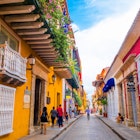

bridal falls in B.C Canada
Not only does Colombia have great coffee, fruit galore and a lively music culture, it’s also one of the most biodiverse countries in the world. Its remarkable range of habitats – from oceans, rainforests and wetlands to grasslands and high-altitude mountains – make the country a paradise for wildlife watching. Although a night of salsa dancing and aguardiente shots are important experiences, discovering Colombia’s diverse fauna will enrich your trip and won’t leave you with a hangover.
- placement: fullWidth
- path: articles/in-content-top
- possible size: [970, 250], [970, 90], [728, 90], [300, 250], [320, 50], [1, 1],
- targeting:
{ "url": "5-ways-to-watch-wildlife-in-colombia" }

Birdwatching
No country on the planet has more bird species nesting in its branches than Colombia. With more than 1900 varieties, the country is becoming a birdwatching hotspot with ample opportunities to observe the feathered beauties.
Nestled high in the Sierra Nevada de Santa Marta overlooking the Caribbean coast lies the renowned ProAves El Dorado Bird Reserve. Accessible from Minca via a long hike or jeep ride, the reserve’s location gives visitors the chance to spot the 20% of the country’s endemic birds who live in these mountains, including Colombia’s national bird, the Andean Condor. In the Central Andes, thirty minutes from Manizales, you can trek through a cloud forest at the Río Blanco Nature Reserve. The reserve is famous for the easy spotting of the typically shy Antpitta species.
Going with a local guide improves your chances of spotting and identifying birds. Birding Santa Marta offers day trips along the north coast, including observing the migratory flamingos who take refuge in the Santuario de Fauna y Flora Los Flamencos, particularly between December and January. For birdwatching excursions around Bogotá, Andes Eco Tours has several options suitable for beginner to expert birders.

Whale watching
Not only is Colombia’s Pacific coast an adventurer’s playground where lush jungles tumble down onto remote beaches, it’s also a stop for migrating humpback whales escaping the icy Antarctic waters. Every year between June and October up to 3,000 humpback whales appear along Colombia’s western coast to give birth and nurse their young in the warm water. The best places to observe these magnificent mammals are Bahía Solano, El Valle and Nuquí in Chocó, and Bahía Málaga near Buenaventura. El Valle is a great base to organize a trip to the Utría National Park where you can observe whales from land. Tours can be arranged at The Humpback Turtle hostel in El Valle. Alternatively, stay at El Cantil Ecolodge Hotel in Nuquí where you can see whales jumping while having lunch.
- placement: fullWidth
- path: articles/in-content-middle
- possible size: [970, 250], [970, 90], [728, 90], [300, 250], [320, 50], [1, 1],
- targeting:
{ "url": "5-ways-to-watch-wildlife-in-colombia" }
With no roads connecting Chocó to the interior of the country, you'll need to fly in. Satena Airlines and Antioquia Air offer flights to Quibdo, Nuquí and Bahía Solano from major cities.

Marine life
With a great stretch of coastline and two distinct oceans embracing the northern and western shores, life underwater is a magical wonderland. On the wild Pacific coast, Isla Malpelo is one of the best shark diving destinations on earth. Advanced scuba divers can fight the strong current to swim alongside hammerhead sharks, white tips, silky sharks, whale sharks, manta and eagle rays. Further south, the incredibly biodiverse Isla Gorgona offers snorkelers and divers heaps of sea life to observe, including humpback whales. Colombia Dive Adventures operates in both Malpelo and Gorgona.
Where the Pacific is cold and rough, the Caribbean is warm and calm – with coral reefs perfect for snorkelers and divers of all levels. Belonging to the third largest barrier reef in the world and the UNESCO Seaflower Biosphere Reserve, the Archipelago of San Andrés and Providencia is abundant with marine life. Species include dolphins, squid, turtles, stingrays, jellyfish, among many others. To witness an astonishing natural phenomenon, visit Providencia during the rainy season (April to July) when thousands of black crabs migrate from the mountainside to lay their eggs on the beach. A month later, the baby crabs leave the seashore and follow their parent’s trail back up in the mountain.

Colombian Safari
Where the Andes end in northeast Colombia, the landscape opens up into a vast grassland savanna that stretches all the way east into Venezuela. Known as Los Llanos, the tropical plains were once guerrilla territory. Fortunately, with increased stability this region – nicknamed 'the Colombian safari' for the variety of species that inhabits the forests, rivers, lagoons and endless prairies – is now open to travelers.
- placement: native
- path: articles/in-content-native
- possible size: [f, l],
- targeting:
{ "url": "5-ways-to-watch-wildlife-in-colombia" }
One of the most enchanting areas in Los Llanos is the Hato La Aurora Nature Reserve, located a bumpy 6-hour 4x4 drive northeast of Yopal, the capital of Casanare department. Sightings include capybaras (largest rodent in the world), caimans, anacondas, giant anteaters, deer, foxes and a multitude of bird species. Lucky visitors may even spot pumas and jaguars! Couple wildlife sightings with spectacular sunsets, followed by a never-ending starry night sky, and Los Llanos is nature at its purest.
EasyFly, Latam and Avianca fly direct from Bogotá to Yopal. Aventur Eco Tours, a Yopal-based travel agency, offer multi-day tours to Hato La Aurora, as well as day trips from Yopal to observe wildlife on foot, horseback or by canoe.

Pink dolphins
Found in the basins of the Amazon and Orinoco Rivers, Amazon river dolphins are born dark grey and slowly turn pink with age. According to local folklore, river dolphins are mythical creatures who have the power to transform into handsome fishermen at night to come ashore, seduce girls and impregnate them.
To spot these shape-shifting casanovas, head to Leticia, a great jumping-off point to explore the Amazon jungle. The reliable Amazon Jungle Trips tour company arranges multi-day trips to the Reserva Natural Zacambú, a lodge set along the banks of the Yavarí River. Not only will you have the opportunity to observe dolphins, but birds, monkeys and caimans, too.
Alternatively, fly to San José del Guaviare, the capital of the Guaviare province. Once a no-go zone for foreigners, the town and the surrounding jungle are slowly becoming a prime ecotourism destination. 70 km from the town lies Damas del Nare Lake: a remote tropical paradise home to dolphins and a host of incredible fauna and flora. Local tour company, Guaviare Biodiverso.travel organizes trips here.
- placement: fullWidth
- path: articles/bottom
- possible size: [970, 250], [970, 90], [728, 90], [300, 250], [320, 50], [1, 1],
- targeting:
{ "url": "5-ways-to-watch-wildlife-in-colombia" }
Explore related stories







 Budget TravelEverything you need to know about tipping in North and South America
Budget TravelEverything you need to know about tipping in North and South AmericaJul 31, 2024 • 4 min read
 Water SportsWhy Belize is better for scuba diving than the Great Barrier Reef
Water SportsWhy Belize is better for scuba diving than the Great Barrier ReefMay 21, 2024 • 5 min read

